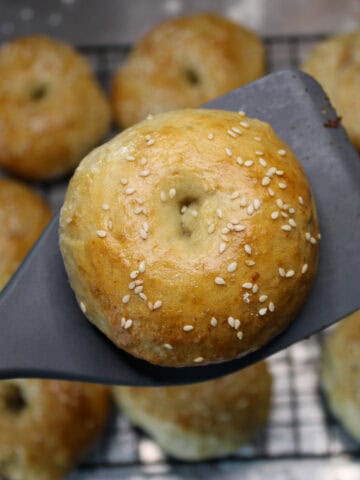Pot pies, hand pies, galettes, poptarts, regular tarts, sandwich cookies, turnovers, cinnamon scraps, pinwheels, empanadas... The list of things you can make with a solid pie crust recipe is endless. You can even fry it instead of bake it.

Notes
- Par-Bake and Bake Ahead: You can absolutely par-bake (partially bake) and fully bake this recipe ahead of time. You can also freeze the dough, thaw in the fridge the day before you need it, and then roll it out and use as usual. Don't thaw on the counter unless you're sure you'll remember it before the butter gets warm!
- Top and Bottom Crust: Just double this recipe straight up if you need a top and bottom crust.
Storage
If you're making this ahead of time, just wait until the pie crust cools and then cover it in plastic wrap. It can sit at room temperature for a day or overnight just fine.
If you're freezing the pre-baked dough, shape it into a thick disc, and then wrap it tightly in plastic wrap. You can freeze it for 3-4 months.
FAQ
When cold butter meets a hot oven, it quickly turns to steam, leaving behind pockets of air. Those pockets shape some of the flakiness that you want to have in your dough.
When warm butter meets a hot oven, it will just melt. You will end up with a pie dish full of bubbling liquid butter instead of a flaky, cooked crust (you may have to clean the bottom of your oven as well).
There can be a number of reasons why this happens, but I find there's one culprit in particular that is often to blame: stretching while rolling or handling. If you're rolling out your pie dough and it seems to be fighting you, retracting after you've run the rolling pin over it, you might be stretching it instead of rolling it. This is typical of dough that's been rolled too much, either because you've been a little too zealous or because the dough was too cold to roll out smoothly at first. Here are some tips:
-Allow your dough to warm up slightly before rolling. Not enough to where the butter becomes warm, but just perhaps a few minutes on the countertop rather than rolling straight from the refrigerator. It should roll easily and quickly, and you shouldn't have to smash it to get it to move somewhere.
-Oversize your crust. My crusts are often imperfect, and that's ok. I compensate for my lack of perfection by rolling my crust slightly larger than I know I will need it. This not only gives me a big of wiggle room to allow for small amounts of shrinkage, but it also ensures I have enough dough to tuck under at the edges, making my border decorations easier to shape.
-Do not stretch or manhandle the dough as you put it in the pie pan or as you're shaping it. Stretching it and sticking it down will just cause it to retract later, especially as the steam begins to escape from the butter. Make it the right size the first time.
Related
Looking for other recipes like this? Try these:

Grace Says:
If your parchment paper keeps rolling up on you irritatingly, crumple it into a ball and then flatten it out again.
📖 Recipe

Pie Crust for Anything
Ingredients
- 1 ½ cups flour
- ½ t salt
- ½ T sugar
- 14 T unsalted butter or lard, cold If using salted butter, eliminate salt.
- ⅓ cup and 2-4T water, cold.
Instructions
- Mix dry ingredients together in a large bowl. Cut cold butter or lard into small chunks, and then add to the dry ingredients. Work the butter into the flour with your fingers, breaking it up and rubbing it in. Work quickly so the heat from your hands doesn't soften the butter too much. If you start to see any shine on your fingers or if the butter squishes easily, put it in the fridge for 30 mins. After a few mins, you should have a crumbly mixture, with pieces of butter no bigger than almonds (smaller is ok).

- Add the water and stir to hydrate the flour and butter mixture. When the water seems well incorporated, give it a few quick kneads just to bring it together into a ball. If the dough seems too dry and you have lots of excess dry flour, add 1-2T more of cold water and mix again.
Laminated (Puffy) Dough
- Laminating dough will create many more layers in your pastry, and will cause it to puff up when baked. If you're making something like danishes or pain au chocolate, this is a good method. Ensure you keep the dough cold at all times."Roll and fold:" Sprinkle the counter with flour and roll out the dough to ¼" thick. You can add small additional sprinkles of flour on sticky spots. Try to make it into a rectangle. Fold the dough in half, then in half the other way. Wrap in plastic wrap, and refrigerate for 15-20 mins.Repeat the "roll and fold" 1 to 2 more times (2 more times will be very puffy). Then roll out in the appropriate manner for whatever you are making and continue with your recipe.
Regular Flaky Dough
- This is a good option for pot pies, hand pies, galettes, etc. Sprinkle the counter with flour and roll out the dough to the appropriate dimensions for your recipe. If the dough is getting too warm, put it back in a covered bowl and let it rest in the fridge for 20 minutes. Then try to roll out again. Work quickly to ensure the dough stays cold enough.If par-baking, bake at 425℉ for 15 minutes with baking beans on parchment. Then remove the beans and parchment, dock the crust (prick with a fork) and continue to bake for another 10-12 minutes or until lightly golden. If it puffs up in the oven, just poke holes in the bubbles to help it flatten back down.










Did you make this recipe? Let me know!